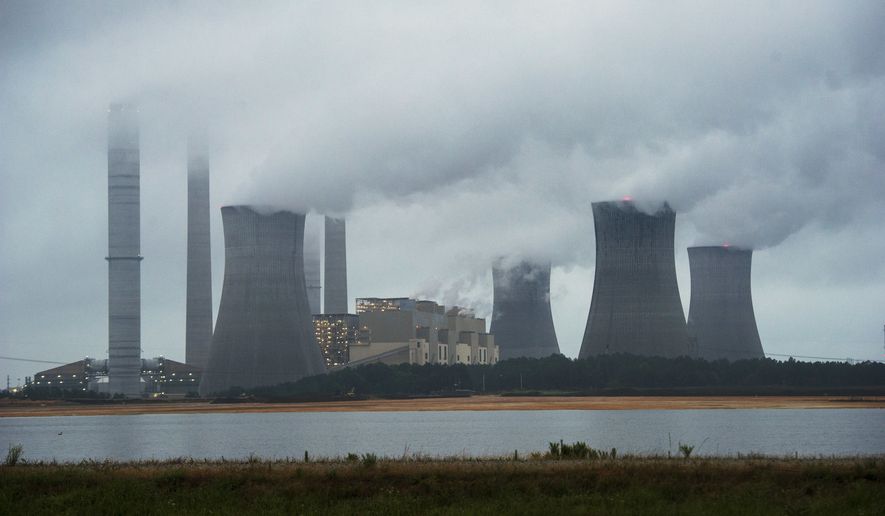President Trump has come under scorching criticism for his climate change policies, but apparently he is doing something right.
The Environmental Protection Agency announced Wednesday that U.S. greenhouse gas emissions dropped by 2.7 percent last year, the first year of the Trump presidency, even as the administration slashed environmental regulations and global emissions continued to climb.
“Thanks to President Trump’s regulatory reform agenda, the economy is booming, energy production is surging and we are reducing greenhouse gas emissions from major industrial sources,” said Andrew Wheeler, acting administrator of the EPA.
The yearslong decline in U.S. emissions has been widely credited to the oil and gas boom. Power plants increasingly turned from coal to natural gas as innovations in extraction technology resulted in lower prices.
“These achievements flow largely from technological breakthroughs in the private sector, not the heavy hand of government,” Mr. Wheeler said. “The Trump administration has proven that federal regulations are not necessary to drive [carbon dioxide] reductions.”
Per-capita greenhouse gas emissions fell to a 67-year low this year, according to the Energy Information Administration, but such landmarks have been largely overshadowed by Mr. Trump’s attack on regulations and his plan to leave the 2015 Paris climate accord.
Major environmental groups offered little in the way of public comment on the decline, although several anti-Trump comments on social media described the report as “lies” and “misinformation.”
Andrea McGimsey, Environment America senior director of global warming solutions, said the Trump administration deserves no credit for the decline, given that “the time period they’re talking about was before anything took place.” She predicted the trend would reverse under Mr. Trump.
“They are actively working to roll back our nation’s best climate programs,” Ms. McGimsey told The Washington Times. “As a result, we’re going to have more of these emissions in the future.”
Meanwhile, the American Petroleum Institute credited the hydraulic fracturing revolution, commonly known as fracking, with driving U.S. carbon dioxide emissions to a 25-year low. It said the U.S. leads the world in oil and natural gas production.
“Americans have the cleanest air in decades due in part to the increased use of natural gas to generate electricity, demonstrating that environmental protection and economic growth are not mutually exclusive,” said Howard Feldman, the institute’s senior director of regulatory and scientific affairs.
The reported emissions from 8,000 large facilities showed that greenhouses gases from power plants have dropped by 4.5 percent since 2016 and 19.7 percent since 2011.
Global carbon dioxide emissions hit record highs last year after rising by 1.6 percent. China, which has attempted to reduce its coal reliance while building coal plants abroad, had the largest increase of any nation at 1.6 percent, according to the June 2018 BP Statistical Review of Global Energy.
About 200 nations joined the Paris agreement, although many European nations are reportedly struggling to meet their goals. Even Germany, a climate leader, has announced that it will miss its 2020 target of reducing emissions by 40 percent.
“While many around the world are talking about reducing greenhouse gases, the U.S. continues to deliver, and today’s report is further evidence of our action-oriented approach,” Mr. Wheeler said.
Environmentalists have blasted the Trump administration for moving to roll back the Obama administration’s higher fuel efficiency standards and never-implemented Clean Power Plan, a directive aimed at reducing emissions from power plants. The Supreme Court put the Clean Power Plan on hold in February 2016 after 27 states and dozens of groups sued, arguing that the EPA had exceeded its authority.
The Trump administration has proposed replacing the Clean Power Plan with the Affordable Clean Energy Rule, which environmentalists have blasted as too coal-friendly.
“President Trump’s regulatory reform agenda is spurring continued innovation in the energy sector,” the EPA press release said. “Under the proposed Affordable Clean Energy Rule, carbon dioxide emissions from the U.S. power sector would continue to decline, with a decrease projected of 34 percent below 2005 levels.”
The United States has led the world in reducing carbon dioxide and other greenhouse gas emissions. The decline is widely attributed to the trend by power plants to replace coal with natural gas, which emits less carbon dioxide and has become cheaper and more widely available as a result of hydraulic fracturing.
The U.S. has boasted the world’s largest emissions reductions nine times this century, said American Enterprise Institute scholar Mark J. Perry.
“For that impressive ’greening’ of America, we can thank the underground oceans of America’s natural gas that are now accessible because of the revolutionary, advanced drilling and extraction technologies of hydraulic fracturing and horizontal/directional drilling, and are increasingly displacing coal for the nation’s electricity generation,” Mr. Perry said in a July report.
• Valerie Richardson can be reached at vrichardson@washingtontimes.com.




Please read our comment policy before commenting.